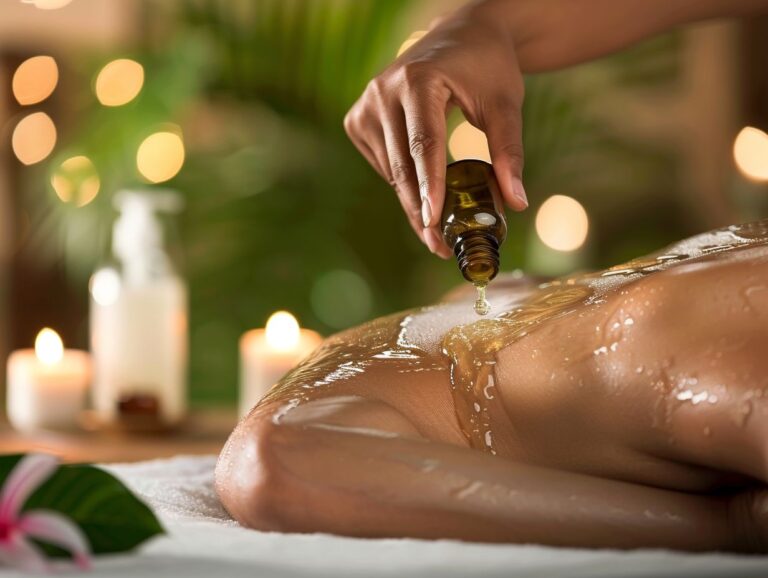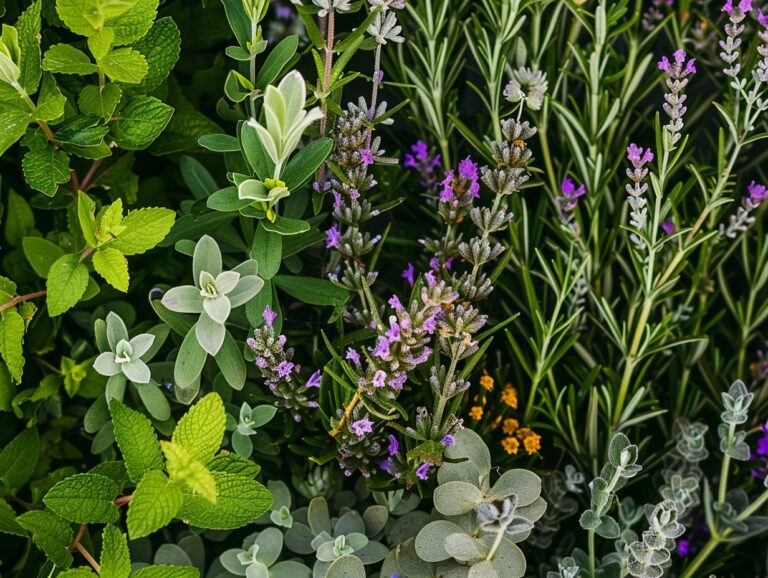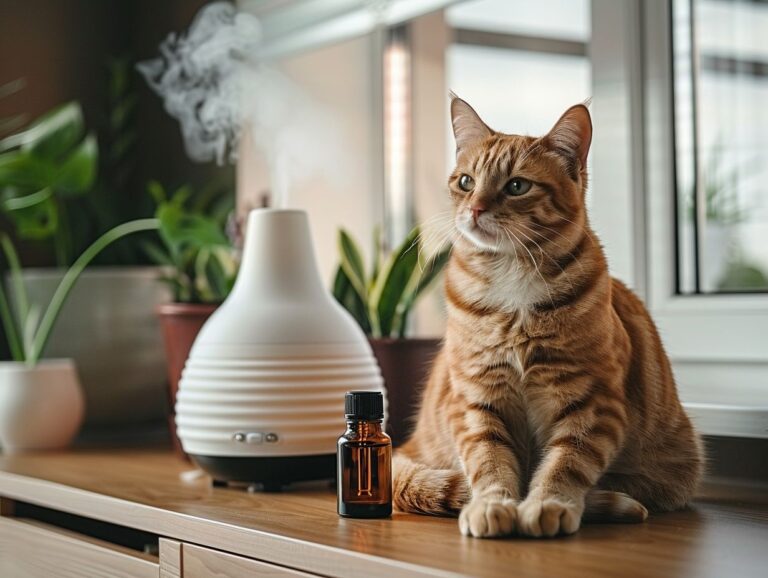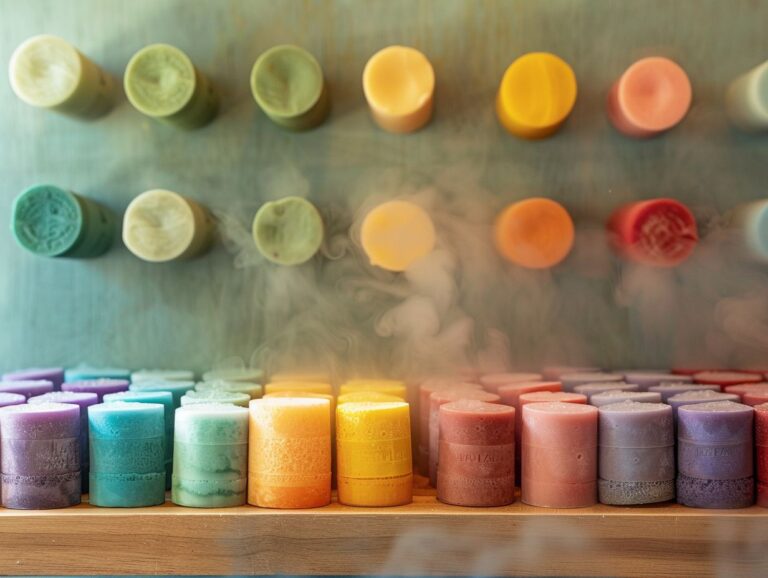Can Aromatherapy Work With No Sense of Smell
Curious about the benefits of aromatherapy but wondering if it can still work without a sense of smell?
This comprehensive article covers everything you need to know about aromatherapy, from its mechanisms to its various types and safety precautions.
Dive into the world of aromatherapy as we explore how it can reduce stress, improve sleep quality, ease pain, boost the immune system, and more.
Discover if aromatherapy can still be effective for those with a loss of smell and alternative methods to consider.
Key Takeaways:
1. Aromatherapy can be beneficial for reducing stress, improving sleep, and boosting the immune system. 2. People with no sense of smell may still benefit from alternative methods such as topical application or consultation with a certified aromatherapist. 3. Proper precautions, such as dilution and patch testing, should always be taken when using essential oils for aromatherapy.
What is Aromatherapy?
Aromatherapy is a holistic healing treatment that uses natural plant extracts, known as essential oils, to promote physical and psychological well-being. These essential oils are derived from various parts of plants and are highly concentrated essences that possess distinctive aromas.
Originating centuries ago, the roots of aromatherapy can be traced back to ancient civilizations like the Egyptians, Greeks, and Romans. These cultures valued the therapeutic properties of aromatic oils and utilized them in perfumes, cosmetics, and religious ceremonies.
The principles of aromatherapy revolve around the belief that inhaling the aroma of these essential oils or applying them to the skin can stimulate brain function, influencing emotions and enhancing overall well-being.
The process of extracting essential oils involves methods like steam distillation, cold pressing, or solvent extraction, ensuring the purest form of the plant essence is preserved.
Therapeutically, essential oils such as Lavender Essential Oil are renowned for their calming properties, promoting relaxation and aiding in alleviating anxiety and insomnia.
On the other hand, Roman Chamomile Essential Oil is cherished for its anti-inflammatory and soothing effects, commonly used in skincare products and to relieve minor skin irritations.
How Does Aromatherapy Work?
Aromatherapy works by stimulating the olfactory system, which is responsible for our sense of smell. When essential oils are inhaled, the olfactory receptors in the nose send signals to the brain’s limbic system, which controls emotions, memories, and behaviors.
This direct connection between the sense of smell and the brain explains why certain scents can evoke powerful emotional responses or trigger vivid memories. By categorizing aromas into groups like floral, citrus, spicy, and woody, aromatherapists can target specific effects on the mind and body. Floral scents, for example, are often associated with relaxation and stress relief, while citrus fragrances are known for their energizing and uplifting properties.
What Are the Benefits of Aromatherapy?
Aromatherapy offers a wide range of benefits, including therapeutic effects on both physical and emotional well-being. The chemical constituents present in essential oils contribute to their therapeutic properties, such as being anti-inflammatory, muscle relaxant, and sleep-inducing.
For example, lavender essential oil is renowned for its calming properties, helping to reduce anxiety and promote relaxation. Peppermint oil, on the other hand, is known for its invigorating effects and ability to alleviate headaches and improve focus. Studies have shown that inhaling certain essential oils can positively impact mood and cognitive function.
Reduces Stress and Anxiety
Aromatherapy has been found to be effective in reducing stress and anxiety levels through the inhalation of calming essential oils. The soothing scents can help relax the mind and body, promoting a sense of calmness and tranquility.
One essential oil known for its stress-relieving properties is Lavender Essential Oil. This versatile oil is widely used in aromatherapy blends to promote relaxation and alleviate anxiety.
Another effective option is E. Joy Bowles, which has been shown to help reduce stress levels and promote a feeling of serenity.
Improves Sleep Quality
Aromatherapy can aid in improving sleep quality by using essential oils with sedative properties that help induce relaxation and promote restful sleep. The calming effects of certain scents can create a soothing bedtime environment conducive to better sleep.
One of the most popular essential oils for enhancing sleep quality is Lavender Essential Oil. Studies have shown that inhaling lavender oil before bedtime can lead to improved sleep efficiency, duration, and overall quality. Additionally, Chamomile Essential Oil is known for its relaxing properties and ability to reduce anxiety, making it another favorable choice for promoting restful sleep.
Research has indicated that aromatherapy may positively impact sleep disorders such as insomnia and improve sleep patterns. For instance, a study published in the Journal of Alternative and Complementary Medicine found that participants who used a blend of essential oils experienced enhanced sleep quality. This highlights the potential of aromatherapy as a natural and effective aid for addressing sleep issues.
Eases Pain and Inflammation

Aromatherapy has been recognized for its ability to ease pain and reduce inflammation in the body.
Certain essential oils, such as lavender and peppermint, are well-known for their pain-relieving effects.
- Lavender oil not only calms the mind but also soothes physical discomfort, making it ideal for headaches and muscle aches.
- Peppermint oil, with its cooling sensation, can help alleviate migraines and tension headaches.
To experience relief, you can inhale these oils by adding a few drops to a diffuser or by diluting them with a carrier oil for topical application, such as massaging onto the affected area.
Boosts Immune System
Aromatherapy is believed to boost the immune system by stimulating the body’s natural defense mechanisms. Essential oils with antimicrobial and antiviral properties can help strengthen immunity and ward off common illnesses and infections.
These potent essential oils, such as Tea Tree Oil and Eucalyptus Oil, have been used for centuries in traditional medicine for their powerful healing properties.
- Tea Tree Oil, often referred to as nature’s disinfectant, is known for its ability to combat bacteria, viruses, and fungi, making it a versatile tool in fighting off infections.
- Eucalyptus Oil, on the other hand, is prized for its decongestant and expectorant qualities, making it especially effective in relieving respiratory conditions and boosting respiratory health.
What Are the Different Types of Aromatherapy?
There are various types of aromatherapy applications, including inhalation, topical application, and aerial diffusion. Each method offers unique benefits and effects based on how the essential oils are delivered to the body.
Inhalation: This method involves breathing in the aromatic molecules of essential oils. Inhalation is quick-acting and can directly affect the respiratory system and provide emotional benefits. For respiratory issues or mood enhancement, inhalation is often recommended.
Topical Application: Applying essential oils directly to the skin allows for absorption into the bloodstream. This method is beneficial for localized issues like muscle tension, skin conditions, or pain relief.
Aerial Diffusion: Diffusing essential oils into the air can purify the atmosphere and provide overall wellness benefits. This method is great for creating a relaxing ambiance or boosting mental clarity.
Inhalation
Inhalation is a common method of aromatherapy where individuals inhale the aroma of essential oils to experience their therapeutic benefits. The olfactory receptors in the nose capture the scent molecules, triggering physiological and emotional responses.
When these scent molecules enter the olfactory system, they travel directly to the limbic system, which is the part of the brain associated with emotions, memory, and behavior. Essential oils such as lavender for relaxation, peppermint for clarity, and citrus for mood enhancement are commonly used in inhalation therapy to evoke specific responses. The inhalation technique allows for quick absorption of the oils, providing almost instant relief or stimulation depending on the desired effect.
Topical Application
Topical application involves applying diluted essential oils directly to the skin for absorption into the bloodstream, allowing for localized and systemic effects. Proper dilution and skin sensitivity considerations are essential when using essential oils topically.
One of the key benefits of using essential oils topically is their ability to target specific areas of concern, such as sore muscles or skin irritations, providing targeted relief. It is important to remember that essential oils are highly concentrated and should always be diluted before applying to the skin. A common dilution ratio is 2-3 drops of essential oil per teaspoon of carrier oil for adults. For children or those with sensitive skin, a lower dilution ratio of 1-2 drops per teaspoon is recommended to prevent skin irritation.
Aerial Diffusion
Aerial diffusion involves dispersing essential oil molecules into the air through diffusers, creating a fine mist or vapor for inhalation. This method allows for the widespread distribution of aromatic compounds, categorizing scents based on their therapeutic effects.
There are various types of diffusers, each offering unique benefits in the diffusion process. From ultrasonic diffusers that use water to nebulizing diffusers that directly disperse undiluted essential oils, the choice depends on the desired intensity and duration of the scent. When selecting essential oils for aerial diffusion, it is essential to consider their properties and the desired therapeutic outcomes.
Calming oils like lavender and chamomile are great for relaxation, while invigorating scents such as peppermint and citrus oils can boost energy and mental clarity.
Can Aromatherapy Work Without a Sense of Smell?

For those with anosmia, aromatherapy becomes a tool for enhancing well-being beyond the olfactory senses. Through techniques like topical application, such as massage oils or lotions infused with essential oils, the skin absorbs the therapeutic properties, offering a direct pathway for the body to benefit from the oils’ healing properties. The emotional benefits of aromatherapy play a vital role in individuals with anosmia, as scents can evoke memories, create a calming ambiance, or even stimulate positive emotional responses.
How Does Loss of Smell Affect Aromatherapy?
The loss of smell, known as anosmia, can impact the effectiveness of traditional aromatherapy practices that rely on inhaling scent molecules. Individuals with anosmia may need to explore alternative methods of aromatherapy to experience the therapeutic benefits of essential oils.
One practical approach for individuals with anosmia is to focus on other senses besides smell when incorporating essential oils into their wellness routines. For example, incorporating topical application techniques such as applying diluted essential oils directly to the skin can still provide benefits. Additionally, diffusing essential oils into the air can offer a passive way to experience their effects without relying solely on inhalation. Experimenting with a variety of application methods allows those with anosmia to customize their aromatherapy experience and potentially discover new ways to reap the benefits of essential oils.
Are There Alternative Methods for Those with No Sense of Smell?
For individuals with no sense of smell, alternative methods of aromatherapy include topical application, aerial diffusion, and direct skin absorption. These methods bypass the need for olfaction while still harnessing the therapeutic properties of essential oils.
Topical application involves diluting essential oils with a carrier oil and applying them directly to the skin. This allows the oils to be absorbed through the skin and enter the bloodstream, providing various benefits such as pain relief, relaxation, and skin rejuvenation.
Aerial diffusion, achieved through diffusers, mists the essential oils into the air for indirect but effective inhalation. This method can help create a calming or uplifting atmosphere, promoting emotional well-being.
Direct skin absorption, such as in massages or baths, allows the oils to penetrate into the body through the skin’s pores, offering localized relief or a full-body sensory experience.
What Are the Safety Precautions for Aromatherapy?
To ensure the safe practice of aromatherapy, it is essential to follow proper dilution guidelines when using essential oils. Diluting essential oils in carrier oils reduces the risk of skin irritation and sensitization reactions.
Conducting a skin patch test before applying any essential oil directly on the skin is crucial to identify potential allergic reactions. This simple test involves applying a diluted mixture of the essential oil to a small area of skin and observing for any adverse reactions over 24 hours.
For individuals new to aromatherapy or those with specific health conditions, seeking guidance from a certified aromatherapist can provide tailored advice on safe and effective use of essential oils. Aromatherapists can help create personalized blends and recommend appropriate dilution ratios based on individual needs and concerns.
Proper Dilution of Essential Oils
Proper dilution of essential oils with carrier oils is crucial to ensure the safe application of aromatherapy. Following recommended dilution ratios helps prevent skin irritation and adverse reactions, maintaining the therapeutic benefits of the oils.
When diluting essential oils, it’s essential to consider the specific use and individual’s sensitivity. For general applications like massage or diffusion, a 2% dilution rate is usually safe (about 12 drops of essential oil per ounce of carrier oil). For certain situations or sensitive skin types, a lower dilution of 1% or even 0.5% may be more appropriate.
Always perform a patch test before using a new blend to check for any adverse reactions. Remember, less is often more when it comes to essential oils; a well-diluted blend can still be powerful and effective while minimizing the risk of skin sensitization.
Patch Testing for Allergies
Conducting patch tests before using essential oils topically is essential to identify potential allergic reactions or skin sensitivities. Applying a diluted oil to a small area of skin helps assess individual tolerance and prevent adverse skin responses.
It is important to dilute the essential oil with a carrier oil, such as coconut or olive oil, before applying it to the skin. This helps reduce the risk of irritation from the concentrated oil.
After dilution, apply a small amount of the mixture to the inner forearm or behind the ear.
Cover the area with a bandage or patch and leave it on for 24 hours. During this time, it’s crucial to avoid exposure to water or excessive sweating, which could disrupt the test results. Monitor the skin for any redness, itching, swelling, or other signs of irritation.
Consultation with a Certified Aromatherapist

Professional aromatherapists possess in-depth knowledge of essential oils and their diverse properties, allowing them to craft customized blends that cater to specific physical, emotional, or mental requirements. These experts understand the importance of proper dilution ratios and can guide individuals on the right dosage for optimal efficacy while minimizing risks of adverse reactions. Certified aromatherapists can recommend suitable oils to alleviate conditions like stress, insomnia, headaches, or muscular discomfort, tailoring treatments to enhance overall well-being.
Frequently Asked Questions
Can Aromatherapy work for someone who has no sense of smell?
Yes, it is possible for Aromatherapy to still have beneficial effects even if you have no sense of smell. Aromatherapy works by interacting with the limbic system in the brain, which is responsible for regulating emotions and memories. This means that even without the sense of smell, the essential oils used in Aromatherapy can still have an impact on your mood and wellbeing.
How does Aromatherapy work without the sense of smell?
Aromatherapy works by using essential oils made from different plants and herbs. When these oils are inhaled or applied to the skin, they interact with the limbic system in the brain, triggering a response that can affect your emotions and physical state. This means that even without the sense of smell, the essential oils can still have a positive impact on your wellbeing.
What are the benefits of Aromatherapy for someone with no sense of smell?
Aromatherapy can have many benefits for someone with no sense of smell. It can help to reduce stress and anxiety, improve sleep, and promote relaxation. It may also have physical benefits such as reducing pain and inflammation, boosting the immune system, and improving digestion.
Can Aromatherapy be helpful for anosmia (loss of sense of smell)?
Yes, Aromatherapy can be helpful for people with anosmia. While it may not be able to restore the sense of smell, it can still have a positive impact on mood and wellbeing. It can also help to stimulate the olfactory nerves, which may potentially aid in the recovery of the sense of smell.
Are there any precautions to take when using Aromatherapy with no sense of smell?
Yes, it is important to be careful when using Aromatherapy for someone with no sense of smell. This is because they may not be able to detect any adverse reactions or irritation from the essential oils. It is best to consult with a certified Aromatherapist and perform a skin patch test before using any essential oils.
What are some alternative methods of using Aromatherapy for those with no sense of smell?
For those with no sense of smell, Aromatherapy can also be experienced through other methods such as applying the essential oils topically or using a diffuser. This allows the oils to enter the body through the skin or respiratory system, still providing potential benefits for mood and wellbeing. Additionally, using scented candles or incense may also provide a similar effect.






